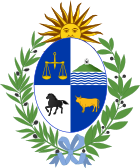

| Department Departamento (Spanish) | |
|---|---|
 | |
| Category | Unitary state |
| Location | Oriental Republic of Uruguay |
| Number | 19 departments |
| Subdivisions | |
 |
|---|
|
Constitution |
|
|
|
Legislative |
|
|
|
|
|
|
See also |
|
|
|
|
Uruguay consists of 19 departments (departamentos). Each department has a legislature, called a Departmental Board, and a chief executive called a Intendente.
The first division of Uruguay into six departments occurred on 27 January 1816. In February of the same year, two more departments were formed, and in 1828 one more was added. When the country's first constitution was signed in 1830, there were nine departments: Montevideo, Maldonado, Canelones, San José, Colonia, Soriano, Paysandú, Durazno and Cerro Largo. At that time, the department of Paysandú occupied all the territory north of the Río Negro, which included the current departments of Artigas, Rivera, Tacuarembó, Salto, Paysandú and Río Negro.
On 17 June 1837, this northern territory was divided in three, by the creation of the departments of Salto and Tacuarembó. At the same time, the department of Minas (which was eventually renamed to Lavalleja) was created out of parts of Cerro Largo and Maldonado. In 1856 Florida was created, and on 7 July 1880 the department of Río Negro was split from Paysandú and Rocha was split from Maldonado. In 1884 Treinta y Tres was formed from parts of Cerro Largo and Minas, while Artigas was split from Salto. The same year the department of Rivera was split from Tacuarembó, and in 1885 Flores was split from San José.
 |
 |
 |
 |
 |
| Series of maps showing the gradual formation of the current 19 departments of Uruguay. | ||||
| Flag or COA |
Department | ISO 3166-2 code |
Formation | Area (km2) |
Population (2011)[1] |
Density (/km2) |
Capital | Capital population |
|---|---|---|---|---|---|---|---|---|
| Artigas | UY-AR | 1884 (from Salto) |
11,928 | 73,378 | 6.15 | Artigas | 40,658 | |
| Canelones | UY-CA | 1816 (as Villa de Guadalupe) |
4,536 | 520,187 | 114.68 | Canelones | 19,865 | |
| Cerro Largo | UY-CL | 1821 | 13,648 | 84,698 | 6.21 | Melo | 53,245 | |
| Colonia | UY-CO | 1816 | 6,106 | 123,203 | 20.18 | Colonia del Sacramento | 26,231 | |
| Durazno | UY-DU | 1822 (as Entre Ríos Yí y Negro) |
11,643 | 57,088 | 4.90 | Durazno | 34,372 | |
| Flores | UY-FS | 1885 (from San José) |
5,144 | 25,050 | 4.87 | Trinidad | 21,429 | |
| Florida | UY-FD | 1856 (from San José) |
10,417 | 67,048 | 6.44 | Florida | 33,640 | |
| Lavalleja | UY-LA | 1837 (as Minas) |
10,016 | 58,815 | 5.87 | Minas | 45,638 | |
| Maldonado | UY-MA | 1816 (as San Fernando de Maldonado) |
4,793 | 164,300 | 34.28 | Maldonado | 62,592 | |
| Montevideo | UY-MO | 1816 | 530 | 1,319,108 | 2,489 | Montevideo | 1,319,108 | |
| Paysandú | UY-PA | 1820 | 13,922 | 113,124 | 8.13 | Paysandú | 76,429 | |
| Río Negro | UY-RN | 1868 (from Paysandú) |
9,282 | 54,765 | 5.90 | Fray Bentos | 24,406 | |
| Rivera | UY-RV | 1884 (as Tacuarembó) |
9,370 | 103,493 | 11.04 | Rivera | 64,465 | |
| Rocha | UY-RO | 1880 (from Maldonado) |
10,551 | 68,088 | 6.45 | Rocha | 25,422 | |
| Salto | UY-SA | 1837 (from Paysandú) |
14,163 | 124,878 | 8.82 | Salto | 104,028 | |
| San José | UY-SJ | 1816 | 4,992 | 108,309 | 21.70 | San José de Mayo | 36,747 | |
| Soriano | UY-SO | 1816 (as Santo Domingo Soriano) |
9,008 | 82,595 | 9.17 | Mercedes | 41,975 | |
| Tacuarembó | UY-TA | 1837 (from Paysandú) |
15,438 | 90,053 | 5.83 | Tacuarembó | 54,757 | |
| Treinta y Tres | UY-TT | 1884 (from Cerro Largo and Lavalleja) |
9,676 | 48,134 | 4.97 | Treinta y Tres | 25,477 |
The General Assembly has the powers to create new departments, requiring a supermajority vote of two thirds in both chambers, as provided by the Constitution in article 85. The General Assembly can also define their borders, requiring the same majority.[2]
The basic statutory framework of departments is defined by Section XVI of the Constitution. Each department has executive and legislative branches, in the form of the Intendant and the Departmental Board respectively. The Municipal Organic Law No. 9515 regulates more specific details of these rules.[3]
The sources of financial resources of the departmental governments are detailed in article 297 of the Constitution, being the departmental taxes, national taxes whose administration is granted to departments, earnings from services or incomes, money obtained from sanctions, donations, inheritances and bequests received and accepted, and their own part of the national budget that they were granted by budget laws.[4]
Since 2009 (Law No. 18567 of 13 September 2009),[5] the Uruguayan departments have been subdivided into municipalities. This system has been widely criticized as a waste of resources, due to Uruguay's small population of 3.4 million. The inaugural municipal elections were held in 2010, with municipal officials assuming office later in the year. Currently there are 125 municipalities.
|
Departments of South America
| |
|---|---|
| Sovereign states |
|
Dependencies and |
|
|
Departments of the Americas
| ||
|---|---|---|
| ||
| Regions |
| |
| Sovereign states |
| |
Dependencies and |
| |